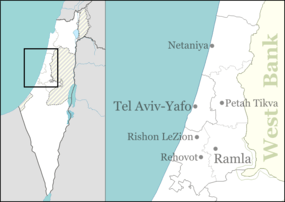Nehalim
| Nehalim נְחָלִים | |
|---|---|
 | |
 Nehalim | |
| Coordinates: 32°3′30.6″N 34°54′49.31″E / 32.058500°N 34.9136972°ECoordinates: 32°3′30.6″N 34°54′49.31″E / 32.058500°N 34.9136972°E | |
| District | Central |
| Council | Hevel Modi'in |
| Affiliation | Hapoel HaMizrachi |
| Founded | 1952 |
| Founded by | Jerusalem Organisation members |
| Population (2015)[1] | 1,690 |
Nehalim (Hebrew: נְחָלִים, lit. Streams) is a religious moshav in central Israel. Located south of Petah Tikva, it falls under the jurisdiction of Hevel Modi'in Regional Council. In 2015 it had a population of 1,690.
History
The Nehalim community was formed in 1938 by a core group of young, religious Bnei Akiva members from Jerusalem. They began agricultural training in Menahemia in the Jordan Valley.[2] In 1944 they moved to a tract of swampy, malaria-infested land and lived in barracks without electricity or running water. Inspiration for the name Nehalim came from the network of brooks and streams in the area. After the 1948 Arab–Israeli War, the residents were moved to the abandoned German Templer village of Wilhelma. The new moshav, in its present location south of Petah Tikva, was founded in 1953, with each family receiving a two-room house and 25 dunams of land.[2]
Landmarks
Nehalim has one main synagogue, established by Jews of European background. In 2012, the moshav's growing Mizrahi population wanted to build a second synagogue to reflect its own religious heritage but the chief rabbi of the moshav, David Greenwald, vetoed it.[3]
See also
References
- ↑ "List of localities, in Alphabetical order" (PDF). Israel Central Bureau of Statistics. Retrieved 16 October 2016.
- 1 2 Nehalim, the wandering moshav The Jerusalem Post
- ↑ Merilos, Itamar (3 May 2012). בית כנסת בנוסח עדות המזרח? לא בנחלים [A Mizrahi synagogue? Not in Nehalim]. Ynet (in Hebrew). Retrieved 5 May 2012.